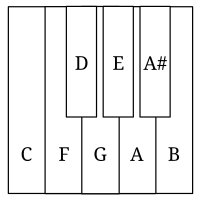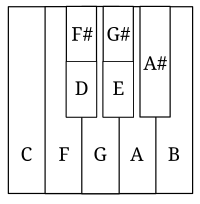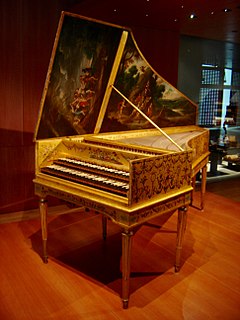
A harpsichord is a musical instrument played by means of a keyboard which activates a row of levers that in turn trigger a mechanism that plucks one or more strings with a small plectrum.

A musical keyboard is the set of adjacent depressible levers or keys on a musical instrument. Keyboards typically contain keys for playing the twelve notes of the Western musical scale, with a combination of larger, longer keys and smaller, shorter keys that repeats at the interval of an octave. Depressing a key on the keyboard makes the instrument produce sounds—either by mechanically striking a string or tine, plucking a string (harpsichord), causing air to flow through a pipe organ, striking a bell (carillon), or, on electric and electronic keyboards, completing a circuit. Since the most commonly encountered keyboard instrument is the piano, the keyboard layout is often referred to as the piano keyboard.

The piano is an acoustic, stringed musical instrument invented in Italy by Bartolomeo Cristofori around the year 1700, in which the strings are struck by hammers. It is played using a keyboard, which is a row of keys that the performer presses down or strikes with the fingers and thumbs of both hands to cause the hammers to strike the strings.
In music theory, a scale is any set of musical notes ordered by fundamental frequency or pitch. A scale ordered by increasing pitch is an ascending scale, and a scale ordered by decreasing pitch is a descending scale. Some scales contain different pitches when ascending than when descending, for example, the melodic minor scale.

A transposing instrument is a musical instrument whose music is recorded in staff notation at a pitch different from the pitch that actually sounds. A written middle C on a transposing instrument produces a pitch other than middle C, and that pitch identifies the interval of transposition when describing the instrument. For example, a written C on a B♭ clarinet sounds a concert B♭.
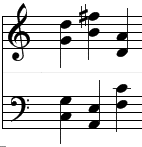
In music theory, a perfect fifth is the musical interval corresponding to a pair of pitches with a frequency ratio of 3:2, or very nearly so.
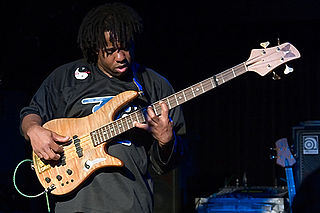
A bassline is the term used in many styles of music, such as jazz, blues, funk, dub and electronic, traditional music, or classical music for the low-pitched instrumental part or line played by a rhythm section instrument such as the electric bass, double bass, cello, tuba or keyboard. In unaccompanied solo performance, basslines may simply be played in the lower register of any instrument such as guitar or piano while melody and/or further accompaniment is provided in the middle or upper register. In solo music for piano and pipe organ, these instruments have an excellent lower register that can be used to play a deep bassline. On organs, the bass line is typically played using the pedal keyboard and massive 16' and 32' bass pipes.

The virginals or virginal is a keyboard instrument of the harpsichord family. It was popular in Europe during the late Renaissance and early baroque periods.

The garmon is a kind of Russian button accordion, a free-reed wind instrument. A garmon has two rows of buttons on the right side, which play the notes of a diatonic scale, and at least two rows of buttons on the left side, which play the primary chords in the key of the instrument as well as its relative harmonic minor key. Many instruments have additional right-hand buttons with useful accidental notes, additional left-hand chords for playing in related keys, and a row of free-bass buttons, to facilitate playing of bass melodies.
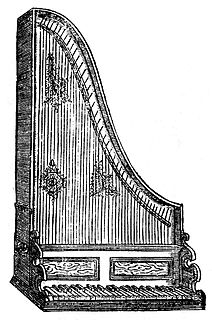
A clavicytherium is a harpsichord in which the soundboard and strings are mounted vertically facing the player. The primary purpose of making a harpsichord vertical is the same as in the later upright piano, namely to save floor space. In a clavicytherium, the jacks move horizontally without the assistance of gravity, so that clavicytherium actions are more complex than those of other harpsichords.

A melodeon or diatonic button accordion is a member of the free-reed aerophone family of musical instruments. It is a type of button accordion on which the melody-side keyboard contains one or more rows of buttons, with each row producing the notes of a single diatonic scale. The buttons on the bass-side keyboard are most commonly arranged in pairs, with one button of a pair sounding the fundamental of a chord and the other the corresponding major triad.
The chromatic harmonica is a type of harmonica that uses a button-activated sliding bar to redirect air from the hole in the mouthpiece to the selected reed-plate desired. When the button is not pressed, an altered diatonic major scale of the key of the harmonica is available, while depressing the button accesses the same scale a semitone higher in each hole. Thus, the instrument is capable of playing the 12 notes of the Western chromatic scale. The chromatic harmonica can thus be contrasted with a standard harmonica, which can play only the notes in a given musical key.
An enharmonic keyboard is a musical keyboard, where enharmonically equivalent notes do not have identical pitches. A conventional keyboard has, for instance, only one key and pitch for C♯ and D♭, but an enharmonic keyboard would have two different keys and pitches for these notes. Traditionally, such keyboards use black split keys to express both notes, but diatonic white keys may also be split.
Tremolo harmonicas are a type of harmonica, distinct by having two reeds per note. In a tremolo harmonica the two reeds are tuned slightly off a reference pitch, one slightly sharp and the other slightly flat. This gives a unique wavering or warbling sound created by the two reeds being not exactly in tune with each other and difference in their subsequent waveforms acting against one another. The degree of beating can be varied depending on the desired effect. Instruments where the beating is faster due to the reeds being farther apart from the reference pitch are called "wet", whereas those where the beating is slower and less noticeable due to the reeds being more closely in tune are called "dry".
The oval spinet is a type of harpsichord invented in the late 17th century by Bartolomeo Cristofori, the Italian instrument maker who later achieved fame for inventing the piano. The oval spinet was unusual for its shape, the arrangement of its strings, and for its mechanism for changing registration.

Diatonic and chromatic are terms in music theory that are most often used to characterize scales, and are also applied to musical instruments, intervals, chords, notes, musical styles, and kinds of harmony. They are very often used as a pair, especially when applied to contrasting features of the common practice music of the period 1600–1900.

The harpsichord was an important keyboard instrument in Europe from the 15th through the 18th centuries, and as revived in the 20th, is widely played today. This article gives a history of the harpsichord; for information on the construction of this instrument, its variant forms, and the music composed for it, see harpsichord.
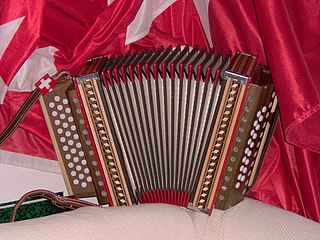
The Schwyzerörgeli is a type of diatonic button accordion used in Swiss folk music. The name derives from the town/canton of Schwyz where it was developed. Oergeli is the diminutive form of the word Orgel (organ). Outside of Switzerland the instrument is not well known and hard to find.

A free-bass system is a system of bass buttons on an accordion, arranged to give the performer greater access to playing melodies on the left-hand manual of the instrument and to forming one's own chords, by providing a buttonboard of single-note buttons with a range of three octaves or more, in contrast to the standard Stradella bass system which only allows bass notes and preset major, minor, dominant seventh, and diminished chords. The term "free-bass system" refers to various left-hand manual systems that provide this functionality:
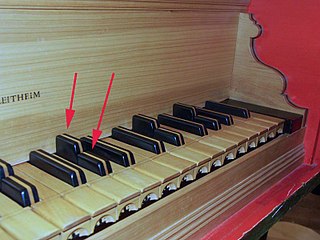
A split sharp is a kind of key found in some early keyboard instruments, such as the harpsichord, clavichord, or organ. It is a musical key divided in two, with separately depressible front and back sections, each sounding its own pitch. The particular keys that were split were those that play the sharps and flats on the standard musical keyboard.
Split sharp. A sharp key divided or 'split' into two parts: the front part is about one third the length of the whole. Usually the back part is set slightly higher to facilitate playing. Each part has its own [parts] so that two notes are available. In Italian instruments it was common...to provide split sharps for e♭/d♯ and g♯/a♭. The usual practice was to put on the front part the note that would normally be found there, e.g. e♭ and g♯.




